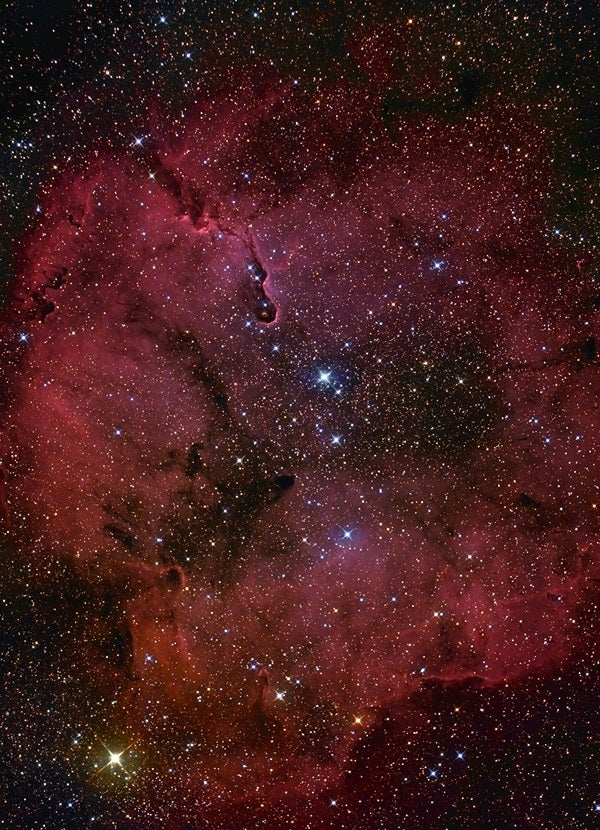Autumn brings the gentle glow of the Milky Way high overhead. To the west, it arises from the stars of Cygnus, while to the east, it flows toward Cassiopeia. In between those two dominant constellations, the rich star clouds of our galaxy pass through a comparatively inconspicuous constellation, Cepheus the King.
The main stars that form the constellation are usually connected on star charts in a pattern resembling a house. Gamma (γ) Cephei marks the peak of the steeply pitched roof, while Alpha (α), Beta (β), Zeta (ζ), and Iota (ι) form the slightly slanted walls and foundation. This month, our visit will be confined to the house’s “basement.”
Aim your binoculars south of the line connecting Alpha and Zeta. There, you’ll notice a 4th-magnitude star. Mu (μ) Cephei certainly doesn’t distinguish itself for its brightness, but it more than makes up for that with its color. You may know Mu by its descriptive nickname, Herschel’s Garnet Star. William Herschel described Mu with that colorful adjective in 1783, when he wrote, “It is of a very fine deep garnet colour . . . and a most beautiful object, especially if we look for some time at a white star before we turn our telescope [or binoculars] to it.” Take a look for yourself and repeat Herschel’s observation by comparing Mu Cep to surrounding stars. Mu appears reddish-orange through binoculars.
Mu Cep is classified as a red supergiant star. Not just any red supergiant, mind you, but one of the largest known. Mu is estimated to be 1,260 to 1,650 times larger than our Sun. If we could place it in the center of our solar system, the star’s edge would lie between the orbits of Jupiter and Saturn.
Mu is also a variable star that is perfect for binocular study every night you head out. Over a period that averages 730 days, Mu slowly fluctuates in brightness from a maximum of magnitude 3.4 to a minimum of 5.1.
If your binoculars’ view spans at least 6°, you can find our next target by sliding Mu toward the western edge of the field. As you do, a slender triangle of stars slips into the eastern half. The base of the triangle is formed by Zeta and Epsilon (ε) Cephei, while Delta (δ ) Cephei marks its apex. Focus your binoculars its way and you will be greeted by a colorful pair of stars. The brighter, golden primary, known as Delta Cephei A, shines on average at 4th magnitude. Its pale blue 6th-magnitude companion (Delta Cephei C) lies 41″ to the south-southwest. The color contrast will remind many of Albireo in Cygnus.
In 1784, Delta Cephei A, a yellow supergiant star, was discovered to vary in brightness by British astronomer John Goodricke, who was but 19 years old at the time. Sadly, Goodricke died just two years later from pneumonia, purportedly contracted while observing this same star on a cold night.
You can’t tell by looking at it, but Delta Cephei A is one of the most important stars in the entire sky. Not for its appearance, but rather, for what it represents. Delta oscillates between magnitudes 3.5 and 4.4 over a precise period of 5.633 days. Graphically plotting its magnitude over the passage of time reveals that Delta Cephei’s light curve resembles a shark’s dorsal fin, with a steep ascent toward maximum and a more casual descent to minimum.
Today, we recognize Delta Cephei A as the prototype of a family of variable stars known as Cepheids. While working at Harvard College Observatory in 1912, Henrietta Swan Leavitt discovered a curious thing about Cepheids. Not only do they all share the same shark-fin light curve, they all show a distinct relationship between their periods and intrinsic brightness, or luminosity. The longer the period, the greater their luminosity. By comparing a Cepheid’s luminosity with its observed apparent magnitude, astronomers can calculate the star’s distance.
Delta Cephei is a great variable star. As luck would have it, those other two stars in our slender triangle — Epsilon and Zeta Cephei — make perfect comparison stars. Zeta shines steadily at magnitude 3.3, closely matching Delta’s max brightness, while 4.2-magnitude Epsilon is close to the minimum.
Have a favorite binocular target that you’d like to share with the rest of us? Email your suggestions to me via my website, philharrington.net.
Until next month, remember that two eyes are better than one.










